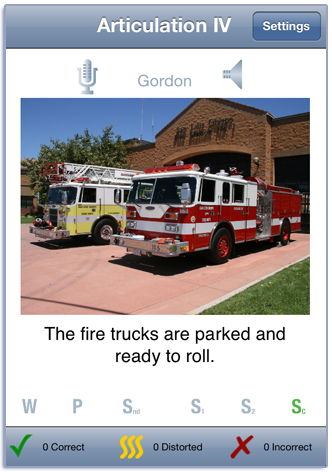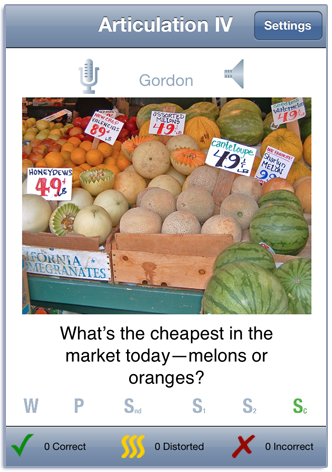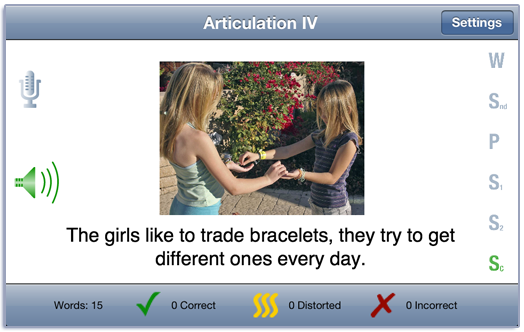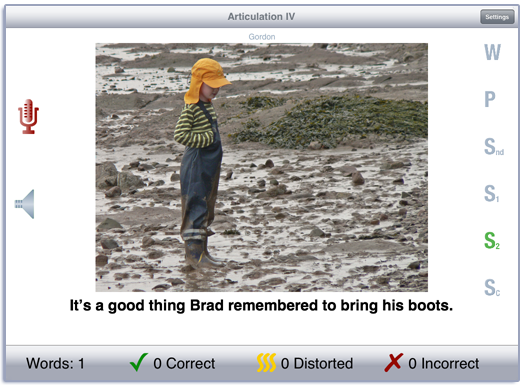
This app is based on the Articulation IV game from LocuTour. It teaches receptive and expressive language skills while children practice their good speech.
Tap the Play button to start. A picture is displayed on the screen. Each picture has a word, phrase, sounds, and sentences associated with it. To hear the word, tap the picture or tap the speech production button labeled W. In landscape view, the speech production buttons are on the right-hand side of the screen. In portrait view, they are at the bottom of the screen. The text of the speech production is shown below the picture. It can be hidden or displayed by toggling the “Show text below picture” button on the Options screen. Swipe right-to-left to move to the next word.
If your device is capable of recording, there will be a microphone and speaker above the picture. Tap the microphone to begin recording. After a short delay it will turn red. After it turns red, say the target word or sentence. Tap the microphone again and the speaker will turn green. Tap the speaker to hear the speech production played back.
Score the child’s speech production using the Correct, Distorted, and Incorrect buttons at the bottom of the screen. If the word was pronounced correctly, tap the green check. If not, tap the red x. If the pronunciation was distorted, tap the wiggly yellow lines. You can record and score as many times as you wish.
The client may listen to the word again by tapping on the Word button. Then click on the Sound button to hear the word segmented into individual phonemes. Listen to and imitate the sounds as they are pronounced. When there is accuracy at the phoneme and single word level, the client can use the Phrase button to hear the word used in a simple phrase. After listening carefully, the client will repeat the phrase. Then the client is ready to hear the word used in a sentence. There are three sentences of increasing complexity. The Sentence 1 button has a simple sentence, Sentence 2 has a more complex sentence, and Sentence 3 has the most complex sentence. The client will repeat the sentences and may make up their own sentences using the target word and the picture for inspiration.
You view the settings by tapping the Settings button at the top of the main game-play screen or at the bottom of the intro screen.
Pick a category from the Categories option. There are five categories of words: R, Vocalic R, S, L, and Th. There are sub-categories within each category.
To view the word list, tap View Word List. You can download a list of the words from our website.
The Options tab lets you sign in with the child’s name and the app will remember the name until you change it. If you enter a name the results files will be stored with the name appended. e.g. Artic IV Results Child One 2015-02-27.html
When you change the name a new file of results will be created. If you want to clear out the current results file, but not change the name, you can touch the Reset Scoring button.
The Results tab shows the results for the day. For each category, the app collects data on the total Visual Presentations (number of screens viewed), taps on the Correct Button, Distorted button, and Incorrect button, and the total Auditory Presentations (the sum of the taps on the picture, and the speech production buttons). A new results file is created when you change the “Sign In” name or when the day changes.
You can print the results or use iTunes to copy the day’s results file to your computer for printing or archiving. To view the results pages in iTunes, plug your iPad or iPod into your computer. Open iTunes. Under Devices you’ll see your device. Click on the device and look at the top of the screen. You will see a tab labeled Apps. Under that tab, there is a section for File Sharing. The Show Me app will be displayed. In the documents list next to it you will find all of the results pages that are stored on the device. Drag them to your desktop. They will open in your web browser where you can print them.
This task requires the ability to attend to a series of complex auditory stimuli, analyze the sound segments, and imitate these sounds in sequence. It requires auditory processing at the sound, syllable, phrase, and sentence levels with imitative or spontaneous expressive articulatory production.
Created by Marna Scarry-Larkin, MA, CCC-SLP and Elizabeth Price, MA, CCC-SLP. Photos were taken by Sam Larkin, Marna Scarry-Larkin, Steve Price, and Nancy Scarry. They were adapted for iOS by Nancy Scarry.




